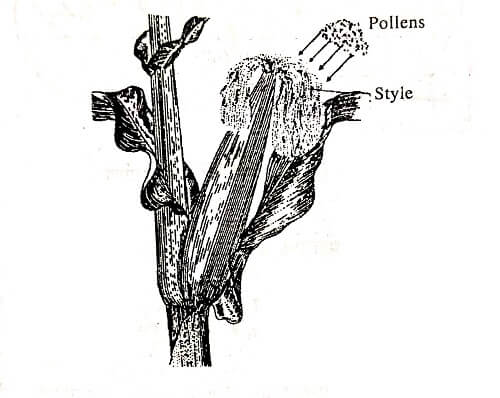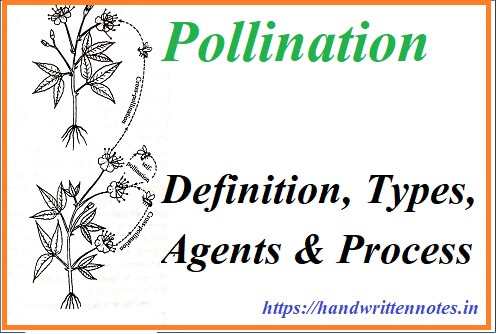Here in this article, we are going to discuss “Pollination: Definition, Types, Agents & Process”. This topic is very important with respect to science students. we will try to teach you in a very simple way by including all important points with examples.
Pollination is the process of transfer of pollen grains for fertilization. In the pollination pollen grain transferred from an anther to the stigma of the same flower or of a different flower. Pollination is the main characteristics feature of gymnosperms and angiosperms.

Types of Pollination
There are two types of pollination found in nature.
1. Self-pollination and 2. cross-pollination
1. Self-Pollination: Types, Adaptations, Merits & Demerits
As we already know that in the case of self-pollination only a plant is involved for both gender. Self-pollination is further divided into two types
I) Types of Self Pollination
Self-pollination and cross-pollination having it’s on importance. Now see the merits and demerits of self-pollination.
II) Merits of self-pollination
- In the self-pollination, pollen grains are not wasted in the case of self-pollination,
- The purity of generation is maintained in the alternation of generation.
III) Demerits of self-pollination
- New and healthy and varieties are not formed after self-pollination .
- Self-pollination results in weaker progeny producing weaker seeds and plants.
IV) Adaptations and requirements for self-pollination
The major requirements which are very important for self-pollination. Here is a list of measure requirements or adaptations.
- Homogamy
Maturity time of anther and stigma of bisexual flower should be the same. This process is called homogamy. Growth, bending for the folding process of anther and stigma should be closed to each other in respect of the maturity time.
- Bisexuality
Hermaphrodite or bisexual flower is very important for self-pollination. In the simple word, both male (androecium) and female sex organs (gynoecium) should be in a flower.
- Cleistogamy
In the case of some plants, they never open to ensuring complete self-pollination. Such type of plants never secretes nectar. Oxalis, viola are examples of cleistogamy.
Read more
Pollination: Definition, Types, Agents & Process
Reproduction in Flowering plants: Types, Process and Examples
2.Cross-Pollination: Types, Adaptations, Merits & Demerits
Transfer of pollen grains from the flower of one plant to the stigma of the flower of another plant is called cross-pollination.
I) Requirements or adaptations for cross-pollination
Cross-pollination is nature favourite. This is very important to survive in a changing the environment. These Some requirements for cross-pollination
- Unisexuality
This is the condition of the plant, capable of producing only male or female gametes. The plant never has both sex organs. In other word stamen and carpels are found in different flowers never on the same flower.
There are two types of plants on the basis of unisexuality
A) Monoecious plants- male and female flowers are born on the same plant
B)Dioecious plant- male and female flowers are born on the different plants
- Dichogamy
The time of maturity of flowers is different from each other to stop or prevent self-pollination.
There are two conditions
Protandry- when stamens Mature earlier than the stigma
Protogy- when stigma mature earlier than stamens
- Heterostyly
In the case of some plants, the length of Style and stamens is different for cross-pollination.
A) Pineyed- flower possesses a long style but short stamens
B) Thrum eyed- flower poses long stamens and short style
- Herkogamy
stigma and anthers mature at the same time in some bisexual flowers. But to avoid self-pollination there is some sort of barriers. The distance between male and female sex organs Structure of corolla has a Peculiar form to avoid self-pollination. In the case of orchid and calotropis pollen Grain are held together to form pollinia which can only be carried away by insects.
- Self sterility or incompatibility
Pollen grains are unable to germinate on the stigma of the same flower. The condition is called self sterility.
II) Agents for Cross-Pollination
Cross-pollination is the transfer of pollen grain from the flower of one plant to the of another plant. This process needs agents to get complete. These agents transfer the Pollen Grain from one plant to another plant. Here we are going to discuss the agents involved in the cross-pollination.
Abiotic agents
Abiotic agents are non-living things which are helpful to transfer the Pollen Grain from one plant to another plant. Examples- wind, water etc
The transfer of pollen grain with the help of water is called hydrophily and the transfer of pollen grain from one plant to another plant by wind is called anemophily. Example: sugarcane, Mage wheat, bamboo, papaya, glasses coconut, Mulberry etc
Examples- Najas, Ceratophyllum, Zostera, Vallisneria etc
Biotic Agents
Biotic agents are the living organisms which are helpful to transfer of pollen grain from one plant to another plant four cross-pollination purpose.
Examples- Insects, birds, Bats, Snails, ants
Transfer of pollen grain from one plant to another plant with the help of an insect is called entomophily Ex- yucca, orchid
Flowers are pollinated by the help of birds is called orthinophily. Sunbirds, hummingbird, crow, bulbul, parrot are the major class of birds which are very helpful to transfer the Pollen Grain from one plant to another plant. Examples– Bignoniya, Agave, Bombax etc
the transfer of pollen grain from one plant to another plant with the help of bats is called Chiropterophily. Examples: Kigelia, adansonia, bauhinia megalandra etc
when the transfer of pollen grain from one plant to another plant with the help of slugs and snails is called malacophily. Examples- Chrysanthemum
Transfer of pollen grain from one plant to another plant with the help of ants is called Myrmecophily. Examples- Anemone nemarosa.
III) Merits of Cross-Pollination
- Seeds are more and viable naturally
- Healthier progeny formed
- Better adaptability of progeny
- New variety can be formed by cross-pollination
IV) Demerits of Cross-Pollination
- Agents required to complete cross-pollination
- Pollen grains are wasted in a large number
Read more
Pollination: Definition, Types, Agents & Process
Reproduction in Flowering plants: Types, Process and Examples
Conclusion
After the pollination fertilization takes place to develop the embryo. Then embryo developed into a whole plant after getting food and nutrition. Here we have only discussed Pollination: Definition, Types, Agents & Process. Now in the next article, we will learn about Fertilization.
If you liked the post “Pollination: Definition, Types, Agents & Process” then leave a comment. if you have any query or suggestion regarding the article must send your query on Email. our email id is handwrittennotes12@gmail.com.
| JOIN OUR SOCIAL MEDIA PLATFORMS | JOIN OUR SOCIAL MEDIA PLATFORMS |
|---|---|
| Join Telegram Channel | Join WhatsApp Groups |
| Like Facebook Page | Subscribe YouTube Channel |
| Follow us on Twitter | Follow us on Pinterest |


I pay a visit every day a few sites and websites to read articles, except this blog gives feature based posts.
Somebody essentially help to make seriously articles I would state. This is the first time I frequented your website page and thus far? I amazed with the research you made to make this particular publish amazing. Fantastic job!
I absolutely love your blog and find many of your post’s to be exactly
what I’m looking for. can you offer guest writers
to write content to suit your needs? I wouldn’t mind
writing a post or elaborating on a number of the subjects you write related to here.
Again, awesome web log!